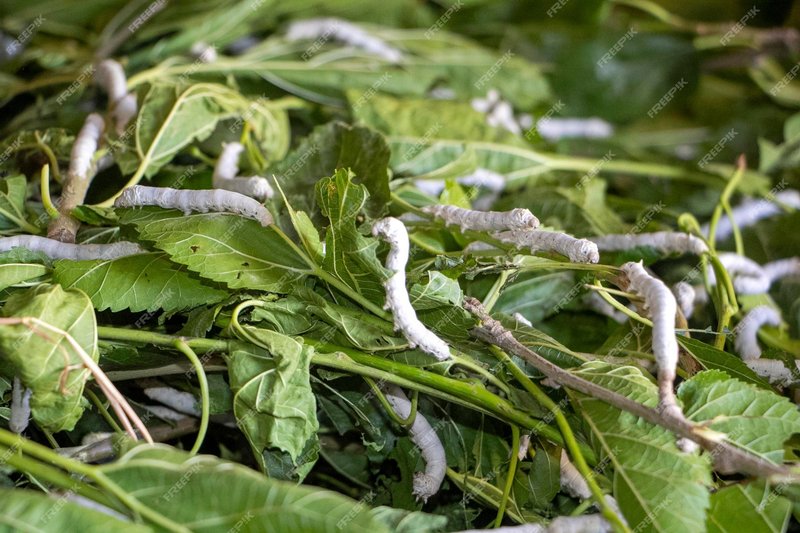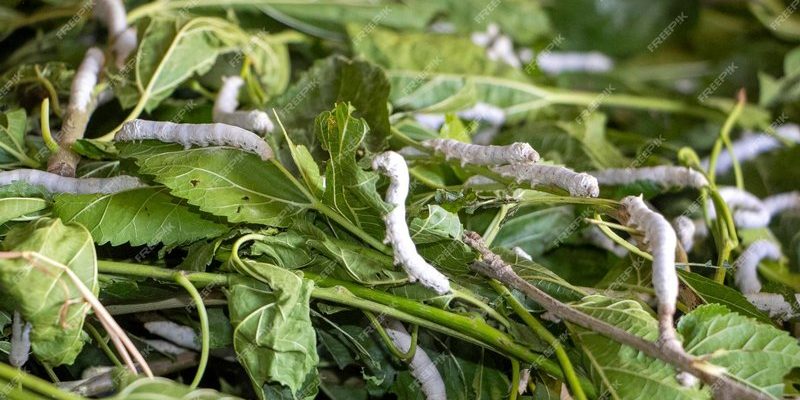
Imagine trying to bake a cake but realizing you’re missing a key ingredient. Your creation wouldn’t turn out right, would it? The same is true for silkworms and mulberry leaves. Without them, these little guys struggle to grow, thrive, and ultimately produce silk. So, what is it about mulberry leaves that makes them the superstar of a silkworm’s diet? Let me explain.
Understanding Silkworms and Their Dietary Needs
Silkworms are the larvae of the silk moth, scientifically known as *Bombyx mori*. These tiny creatures are not just adorable; they have very specific dietary needs. Think of silkworms like toddlers—they need the right nutrients to grow healthy and strong. A silkworm’s diet primarily consists of **fresh mulberry leaves**, which provide them with essential vitamins, minerals, and proteins. They eat a lot of these leaves—sometimes up to 20,000 times their body weight! That’s like a human eating a truckload of food just to grow.
But why mulberry leaves, exactly? Here’s the thing: mulberry leaves are rich in **protein**, which is crucial for the silkworm’s growth and silk production. Without enough protein, silkworms won’t develop properly, leading to smaller cocoons and less silk. Imagine trying to make a cozy blanket with tiny threads—you wouldn’t get very far, right?
Additionally, mulberry leaves are packed with water content, which helps keep silkworms hydrated. Just like we need water to stay refreshed, silkworms rely on these leaves to keep their little bodies happy.
The Nutritional Benefits of Mulberry Leaves
Mulberry leaves are a nutritional powerhouse for silkworms. Let’s break down some of the critical nutrients found in these leaves:
- Proteins: Essential for growth and silk production.
- Vitamins: Contains vitamins A, B, and C, which support overall health.
- Minerals: Important minerals like calcium and phosphorus help in bone development.
- Fiber: Aids in digestion, similar to how fiber helps us keep things moving along.
When silkworms munch on these leaves, they are not just filling their tummies; they’re getting a complete meal that sets them up for success. Think of it like a balanced breakfast—when you start your day with the right foods, you’re more likely to feel energized and ready to tackle whatever comes your way.
You might be wondering how farmers grow mulberry trees. It’s quite an art! Mulberry trees are relatively easy to cultivate, making them a farmer’s best friend. They grow well in various soil types and climates, which is why they’re a staple in many areas where silk production happens.
Harvesting Mulberry Leaves for Silkworms
Harvesting mulberry leaves is a careful process. Farmers need to ensure that the leaves are fresh and free from pesticides or chemicals. Just like you’d want organic produce from the grocery store, silkworms thrive best on clean, chemical-free leaves.
Typically, the best time to harvest is in the morning when the dew is still on the leaves. This keeps them fresh and juicy, just like when you bite into a perfectly ripe fruit. Farmers carefully pick the leaves, ensuring not to damage the tree. It’s a bit like a dance—farmers need to be gentle and deliberate.
Once harvested, it’s essential to keep the leaves cool and dry. Leaving them out in the sun can wilt them quickly, which isn’t good for our little silkworm friends. The fresher the leaves, the happier the silkworms, and ultimately, the better the silk they produce.
How Mulberry Leaves Influence Silk Production
Now, let’s talk about the real reason we’re so interested in silkworms: the silk! The relationship between mulberry leaves and silk production is fascinating. Silkworms that consume a high-quality diet of mulberry leaves are known to produce thicker, stronger silk.
The process works like this: when silkworms eat the leaves, their bodies convert the nutrients into energy. This energy fuels their transformation from tiny caterpillars into mature moths. And when it’s time to spin their cocoons, they use silk fibers made from the proteins they’ve consumed. So, the quality of the mulberry leaves directly affects the quality of the silk. You could say that mulberry leaves are the secret ingredient to superior silk production, much like how top-notch chocolate enhances a cake.
Farmers often track the growth of their silkworms and the quality of silk produced to ensure they’re feeding their worms the best possible diet. It’s a meticulous balance of nature and nurture that results in those shimmering strands we all know and love.
Challenges in Mulberry Leaf Production
Like any crops, growing mulberry trees comes with its challenges. Farmers face pest issues, weather conditions, and diseases that can affect the yield of mulberry leaves. These challenges can impact the silkworms’ diet and, ultimately, the silk production.
Pests can wreak havoc on mulberry trees, devouring the leaves and leaving behind weakened plants. To combat this, farmers often use integrated pest management techniques, which involve using natural predators rather than harsh chemicals. It’s a more sustainable option that benefits both the trees and the ecosystem.
Weather can also play a huge role. Too much rain can lead to leaf rot, while droughts can stress the trees. Farmers need to stay vigilant about the weather and adapt their farming methods accordingly. A good mulberry crop isn’t just a harvest; it’s a labor of love, requiring dedication and care.
In summary, mulberry leaves are not just a snack for silkworms; they are a crucial component of their diet that influences everything from their growth to the silk they produce. Without these leaves, the silk industry would struggle to thrive.
When you consider the journey from mulberry leaf to silk, it’s a beautiful cycle of life, growth, and transformation. The next time you admire silk garments or products, remember the unsung hero behind them: the humble mulberry leaf. These leaves truly are the backbone of the silk industry, showcasing nature’s gifts and the delicate balance of ecosystems.
So, whether you’re studying silkworms or just curious about how your favorite silk scarf came to be, know that mulberry leaves hold the key to this fascinating world. Who knew that something so simple could have such a big impact?

